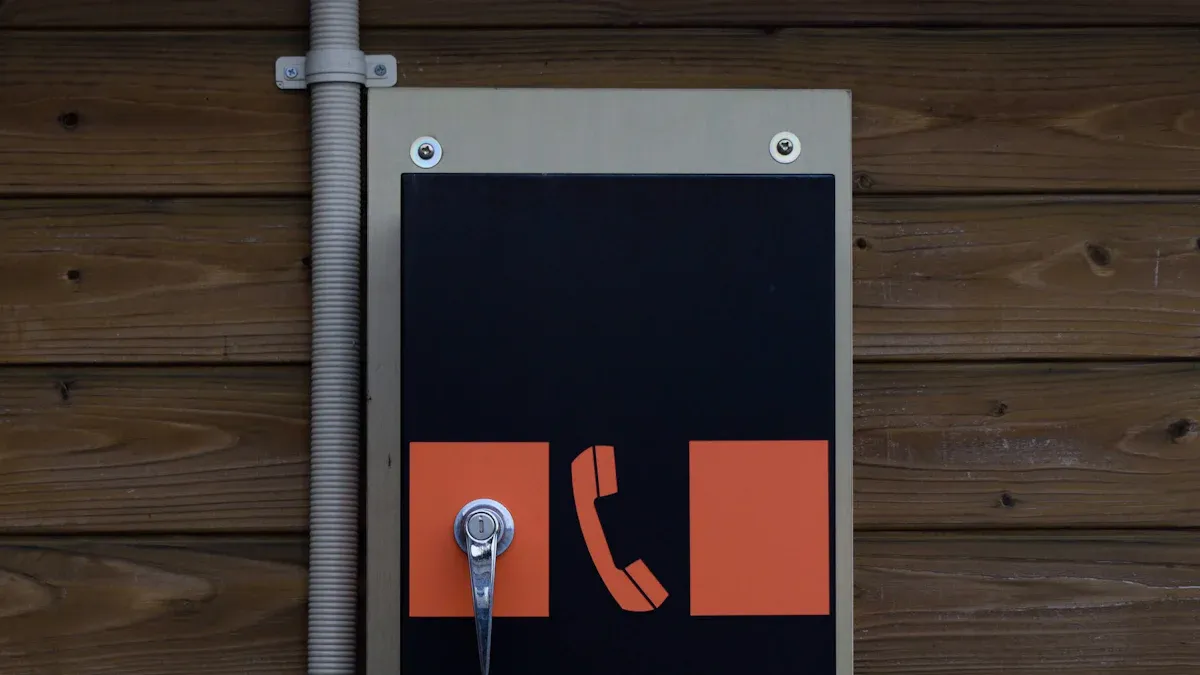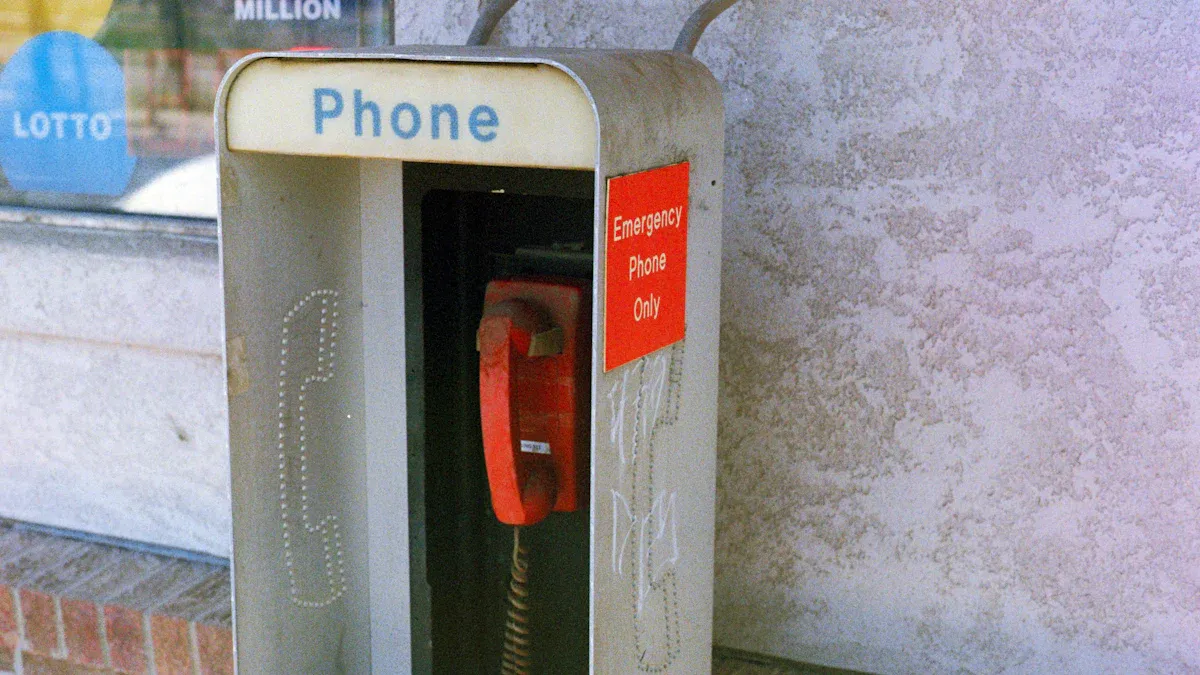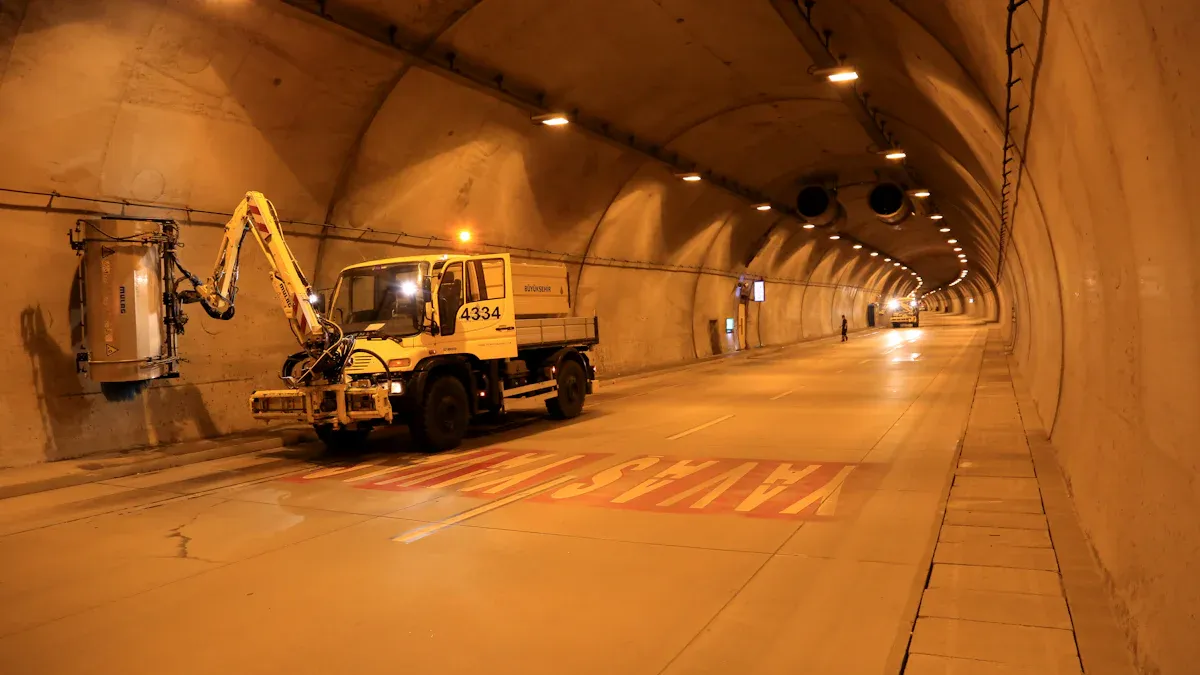
Emergencies in tunnels or on bridges can escalate rapidly. Traffic Emergency Telephones provide a critical lifeline when cell signals are unavailable. These devices, such as the auto dial emergency telephone, guarantee that drivers can immediately reach assistance. The heavy-duty telephone design ensures durability in extreme conditions, making traffic emergency telephones essential for public safety. In urgent situations, every second matters.
The Safety Challenges of Tunnels and Bridges

Limited Escape Routes
Tunnels and bridges often lack sufficient escape routes, making emergencies more dangerous. Drivers and passengers may find themselves trapped with limited options to evacuate. This issue becomes even more critical during fires, accidents, or natural disasters. To address this, experts recommend improving signage for escape routes. Clear, consistent, and effective visual, audible, and tactile signs can reduce confusion, especially in low-light conditions. Here’s a quick look at some key recommendations:
| Recommendation | Description |
|---|---|
| Develop Universal, Consistent, and More Effective Visual, Audible, and Tactile Signs for Escape Routes | Emphasizes the need for uniform signage to minimize confusion during emergencies, especially in low light situations. |
| Develop AASHTO Guidelines for Existing and New Tunnels | Aims to create a single reference for consistent safety criteria across various organizations. |
| Conduct Research and Develop Guidelines on Tunnel Emergency Management | Focuses on incorporating human factors into tunnel design and emergency response planning. |
These measures can help ensure safer evacuations and better emergency management.
Poor Cell Signal Reception
Tunnels and bridges often block cell signals, leaving drivers unable to call for help. This lack of connectivity can delay emergency responses and increase risks. Traffic Emergency Telephones solve this problem by providing a reliable communication method. Unlike cell phones, these devices connect directly to emergency services, ensuring help arrives quickly. Their placement in strategic locations makes them accessible even when cell networks fail.
High Traffic Density
High traffic density in tunnels and on bridges creates another safety challenge. Accidents in these areas can lead to chain reactions, causing severe congestion and delaying emergency vehicles. The confined space amplifies the risks, as vehicles have limited room to maneuver. Effective traffic management systems, combined with tools like Traffic Emergency Telephones, can help mitigate these risks. By enabling rapid communication, these systems ensure faster responses and reduce the chances of secondary accidents.
The Functionality of Traffic Emergency Telephones

Direct Connection to Emergency Services
Traffic Emergency Telephones provide a direct line to emergency services, ensuring help is just a button press away. These devices are designed with features that make communication fast and reliable. For instance, they support hands-free operation, making them easy to use for everyone, including children and the elderly. Backup power supplies keep them functional even during power outages. Additionally, their integration with tunnel broadcasting systems allows emergency calls and announcements to be managed together. Here’s a closer look at their key features:
| Feature | Description |
|---|---|
| System network management and remote maintenance | Enables troubleshooting and maintenance from anywhere using IP networking. |
| Combined with tunnel broadcasting system | Unifies control of emergency calls and announcements. |
| Hands-free operation | Simplifies use with one-button functionality. |
| Backup power supply | Ensures operation during power failures. |
| Intelligent statistics and query | Helps staff analyze traffic incidents and equipment issues. |
| IP transmission mode | Simplifies construction and ensures reliable communication. |
These features make these telephones a dependable tool for emergency communication.
Reliability in Extreme Conditions
Tunnels and bridges often face harsh conditions, from extreme temperatures to high humidity. Traffic Emergency Telephones are built to withstand these challenges. Their heavy-duty design ensures they remain operational in environments where regular devices might fail. Whether it’s a fire in a tunnel or freezing temperatures on a bridge, these telephones continue to function. This reliability gives drivers and emergency responders confidence that communication will not break down when it’s needed most.
Integration with Safety Systems
Traffic Emergency Telephones don’t work in isolation. They integrate seamlessly with other safety systems, creating a comprehensive emergency response network. For example, they connect with surveillance cameras and traffic management systems, allowing operators to monitor incidents in real time. This integration speeds up decision-making and ensures that resources are deployed effectively. By working alongside other technologies, these telephones enhance the overall safety of tunnels and bridges.
Benefits of Traffic Emergency Telephones
Fail-Safe Communication
Traffic Emergency Telephones provide a dependable communication method when other systems fail. Cell networks often become unreliable during emergencies, especially in tunnels or on bridges. These telephones, however, remain operational even in extreme conditions. Their design includes backup power systems and durable materials, ensuring they work when needed most. Drivers can trust these devices to connect them directly to emergency services without delays. This reliability makes them an essential part of any safety system.
Faster Emergency Response
Quick communication saves lives during emergencies. Traffic Emergency Telephones allow drivers to report incidents instantly. Emergency responders receive accurate information directly from the scene, which helps them act faster. Unlike cell phones, these telephones eliminate the need to search for a signal or dial a number. A single button press connects users to help. This speed reduces response times and prevents situations from escalating further.
Enhanced Public Safety
These telephones contribute to overall public safety by creating a secure environment for drivers. Their presence reassures people that help is always available. They also integrate with other safety systems, like surveillance cameras and traffic management tools. This integration allows operators to monitor incidents and coordinate responses effectively. By improving communication and response capabilities, Traffic Emergency Telephones help reduce risks and protect lives.
Real-Life Impact of Traffic Emergency Telephones
Examples of Lives Saved
Traffic Emergency Telephones have proven their worth in countless real-life situations. For instance, during a fire in a European tunnel, a stranded driver used one of these telephones to alert authorities. This quick action allowed emergency responders to arrive promptly, evacuate people, and prevent further casualties. In another case, a motorist on a bridge in Asia used the telephone to report a multi-car accident. The immediate response helped clear the scene and avoid additional collisions. These examples highlight how these devices save lives by enabling fast communication when every second counts.
Lessons from Past Emergencies
Emergencies in tunnels and on bridges have taught valuable lessons about preparedness. One key takeaway is the importance of reliable communication tools. During a blackout in a major U.S. city, cell networks failed, leaving drivers unable to call for help. However, Traffic Emergency Telephones remained operational, providing a lifeline for those in need. Another lesson is the need for proper maintenance. In one incident, a malfunctioning emergency telephone delayed a rescue operation. Regular checks and updates ensure these devices work when they’re needed most.
Tip: Emergency preparedness starts with reliable tools. Keeping Traffic Emergency Telephones in top condition can make all the difference during a crisis.
Role in Disaster Mitigation
Traffic Emergency Telephones play a crucial role in disaster mitigation. They act as a direct link between drivers and emergency services, reducing response times. In large-scale disasters like earthquakes or floods, these devices help coordinate evacuations and manage traffic flow. Their integration with other safety systems, such as surveillance cameras, enhances their effectiveness. By providing a dependable communication method, they help minimize chaos and protect lives during emergencies.
Traffic Emergency Telephones are vital for ensuring safety in tunnels and on bridges. Their reliability and ability to function in extreme conditions make them indispensable. These devices provide a direct connection to emergency services, saving lives when seconds matter. Investing in these systems strengthens public safety and improves emergency response capabilities.
FAQ
What makes Traffic Emergency Telephones better than cell phones during emergencies?
Traffic Emergency Telephones work even when cell signals fail. They connect directly to emergency services, ensuring faster help without needing to search for a signal.
Where are Traffic Emergency Telephones usually installed?
These telephones are placed at regular intervals in tunnels and on bridges. Their strategic locations ensure easy access for drivers during emergencies.
Do Traffic Emergency Telephones require maintenance?
Yes, regular maintenance is essential. Routine checks ensure they stay functional, especially during power outages or extreme weather conditions.
Tip: Maintenance schedules help prevent malfunctions when these devices are needed most.


